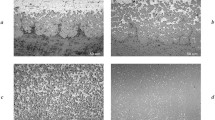Abstract
Electron-probe microanalysis has been applied to the compositions of single-phase intermetallide layers and two-phase reaction zones at the interfaces between liquid aluminum saturated with alloy components at 700°C and iron-nickel alloys having iron contents of 90, 75, 50, 25, 20, 15, and 10 mass %. Binary intermetallides (FeAl3, Fe2Al7, NiAl3, and NiAl2) and a ternary intermetallide FeNiAl9 are formed. All the binary compounds dissolve considerable amounts of the third element (Ni or Fe) and have appreciable homogeneity ranges. The dissolution of the Fe−Ni alloy in the pure liquid aluminum reduces the total thicknesses of the intermetallide layers growing between the alloy and the aluminum by a factor 3–5 by comparison with a saturated aluminum melt.
Similar content being viewed by others
References
M. Hansen and K. Anderko,Binary Alloy Structures, in 2 volumes, Vol. 1 [Russian translation], Metallurgizdat, Moscow (1962).
A. E. Vol,Structure and Properties of Binary Metallic Systems, in 3 volumes, Vol. 1 [in Russian], Fizmatgiz, Moscow (1959).
T. B. Massalski, J. L. Murray, L. H. Bennett, and H. Baker (eds.),Binary Alloy Phase Diagrams, Vol. 1, American Society for Metals, Metals Park, Ohio (1986).
L. F. Mondolfo,Aluminum Alloy Structures and Properties [Russian translation], Metallurgiya, Moscow (1979).
M. K. Khaidar, C. H. Allibert, and J. Driole, “Phase equilibria of the Fe−Ni−Al system for Al content above 50% and crystal structures of some ternary phases”,Zhurn. Metallkunde,73, No. 7 433–438 (1982).
G. Petzow and G. Effenberg (eds.),Ternary Alloys: A Comprehensive Compendium of Evaluated Constitutional Data and Phase Diagrams, Vol. 5, VCH, Weinheim (1991).
V. I. Dybkov, E. S. Meshkov, V. V. Kovylyaev, and G. Z. Omel’chenko, “The solubilities of iron-nickel alloys in liquid aluminum”,Poroshk. Metall., No. 7, 58–62 (1992).
V. I. Dybkov, “Interaction of iron-nickel alloys with liquid aluminium. Part 1: Dissolution kinetics”,J. Mater. Sci.,28, No. 23, 6371–6380 (1993).
V. I. Dybkov, “Interaction of 18 Cr−10 Ni stainless steel with liquid aluminium”,J. Mater. Sci.,25, No. 8, 3615–3633 (1990).
V. I. Dybkov,Growth Kinetics of Chemical Compound Layers, Cambridge International Science Publishing, Cambridge (1998).
Additional information
Institute for Problems of Materials Science, Ukraine National Academy of Sciences, Kiev. Translated from Poroshkovaya Metallurgiya, Nos. 11–12(410), pp. 67–74, November–December, 1999.
Rights and permissions
About this article
Cite this article
Dybkov, V.I. Phase formation at an interface between aluminum and an iron-nickel alloy. Powder Metall Met Ceram 38, 590–596 (1999). https://doi.org/10.1007/BF02676192
Received:
Issue Date:
DOI: https://doi.org/10.1007/BF02676192




